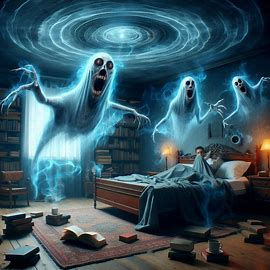The Enigma of Poltergeists: Unraveling the Forces Shaping Our Beliefs and Fears
- Franco Arteseros
- Jun 16
- 4 min read

Unveiling the Mystery of Poltergeists

Poltergeists captivate our imaginations with their bizarre disruptions and mysterious presence. They bring to mind unsettling images of objects moving without explanation and inexplicable noises in the night. But what is a poltergeist really? Is it a manifestation of a spirit, a unique energy force, or simply a result of psychological phenomena? In this exploration, we will unlock the secrets of poltergeist lore, blending historical context with modern science to better understand these elusive entities.
What Is a Poltergeist?

A poltergeist, from the German words “poltern” (to make noise) and “geist” (ghost), refers to a supernatural being associated with haunting disturbances. Unlike classic hauntings tied directly to a spirit, poltergeists are known for their ability to create ruckus and physically engage with their environment.
Signs of poltergeist activity can include:
Unexplained sounds like knocking or banging
Objects moving on their own or being thrown
Changes in temperature that seem abrupt
For example, in a 2015 incident in Monroe, New York, homeowners reported that their doors opened and closed on their own, while dishes flew off shelves without a trace. Many experiences like this lead individuals to believe they are encountering an intelligent presence.

How Does a Poltergeist Work?

Poltergeist activity can be attributed to several theories which often spark intense debate. Some researchers suggest that these manifestations may stem from repressed emotions, particularly in adolescents who are experiencing significant stress. Several studies, including one published in the Journal of Parapsychology, have indicated a correlation between adolescent stress and poltergeist activity.
Alternatively, believers in paranormal phenomena argue that poltergeists are actual entities. The Enfield Poltergeist incident in London during the late 1970s, where furniture moved and objects levitated in front of witnesses, sparked widespread media coverage and public interest. Eyewitness testimonies and audio recordings fueled discussions for decades.
Scientific explanations often attempt to portray these occurrences through the lens of energy fluctuations or quantum theories. For instance, researchers have suggested that electromagnetic fields in certain environments could create sensations leading people to feel supernatural disturbances, though verified evidence remains scarce.
Origins and History of Poltergeist Phenomena
Poltergeist legends have roots embedded in various cultural traditions across time. Accounts date back to ancient Rome, where disturbances were commonly attributed to restless spirits. Medieval European writings often described poltergeists as entities that brought misfortune through pranks.
Prominent historical cases have shaped contemporary perceptions. The Bell Witch incident in early 19th century Tennessee reported continual torment of the Bell family, including unexplained sounds and physical attacks. Meanwhile, the 1970s Enfield case included instances of a girl being physically thrown from her bed, catching the attention of both skeptics and believers.
Cultural interpretations also vary widely. Many cultures see poltergeist activities as manifestations of negative energy, while others regard them as tests of one’s faith or harbingers of change. For example, in some Asian cultures, disturbances are viewed as ancestral spirits seeking attention.
Evolution of the Poltergeist in Media and Science
Poltergeists have left a significant mark on popular culture, featured in classic horror films and literature that shape societal perceptions of the supernatural. Movies like “The Exorcist” and TV series such as “The Conjuring” present poltergeists as sources of dread, fueling public fascination.

Recent psychological studies have shifted focus toward understanding these experiences as potential misinterpretations of environmental factors or psychological stress. A 2020 survey by the Pew Research Center indicated that nearly 30% of Americans believe in ghosts, with many attributing such beliefs to psychological projections during stressful situations.
Investigation methods have also advanced. Paranormal investigators employ devices like thermal cameras and EVP (electronic voice phenomena) equipment to capture evidence. These technologies aim to bridge the gap between belief and skepticism, although results remain inconclusive.
The Future of Poltergeist Research
As technology evolves, so does the study of poltergeists. New tools, including advanced sound detection apps and environmental sensors, could yield deeper insights into reported encounters.
Artificial Intelligence may further revolutionize our understanding by analyzing patterns in poltergeist accounts and uncovering links that elude current human analysis. For example, AI could potentially identify correlations between locations reported for activity and changes in environmental conditions.

Will poltergeist phenomena remain a captivating topic, or will skepticism overshadow these tales? The interplay of human emotion, scientific discovery, and cultural belief will continue to drive interest in these mysterious occurrences.
Enduring Fascination
The allure of poltergeists resonates deeply within our collective psyche, compelling us to confront our fears and curiosity about the unknown. Whether seen as supernatural forces, emotional manifestations, or cultural myths, poltergeists represent the complex interplay of belief and experience.

As we continue to explore these phenomena through research and cultural studies, the legacy of poltergeists will likely endure. The stories surrounding them remind us of our fascination with the unexplained amidst the realms of science, psychology, and spiritual belief.

Franco Arteseros...








Comments